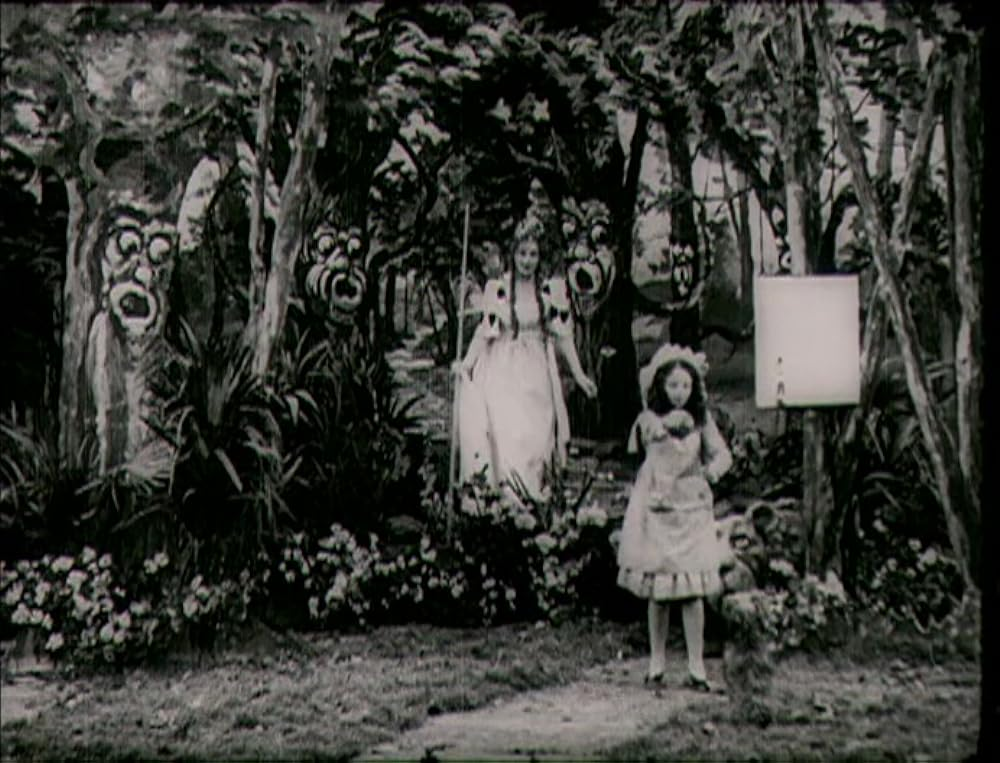
Run Time: 13 minutes. Studio: Selig Polyscope Company. Director: Otis Turner. Writer: Otis Turner. Based on the children's book by L. Frank Baum. Main Cast: Bebe Daniels, Hobart Bosworth, Eugenie Besserer, Robert Z. Leonard, Winifred Greenwood, Lillian Leighton, Olive Cox. Producer: William Nicholas Selig.
Even those who don't know much about old movies, know The Wizard of OZ (1939). Those who know a bit more about film history are familiar with the 1925 movie version starring silent movie comedian Larry Semon and featuring Oliver Hardy as the Tin Man. However, neither of these was the first film adaptation of L. Frank Baum's classic children's book. This 1910 short film often gets completely overlooked among the multiple movie adaptations. While it is certainly one of the most dated of the OZ film adaptions, it has a real charm to it that I simply love.
L. Frank Baum's novel, The Wonderful Wizard of OZ was not the only source material for this film. This film also borrows from the 1902 stage musical The Wizard of OZ as well L. Frank Baum's other OZ books. The 1902 stage play influence is especially all over this short. For instance, this film includes the character of Imogene the Cow. This character did not appear in any of the OZ books but replaced Toto in the stage play. The costumes for some of the characters were also very similar to those used in the play. The character of Eureka the kitten comes from the OZ book, Dorothy and the Wizard in Oz. The villainous Momba was based off the evil witch Mombi from L. Frank Baum's 1904 book, The Marvelous Land of Oz.
This short is in a tradition of short length film versions of novels and plays that were popular around this time period. With their shortened runtime these films relied heavily on the audience having a familiarity with the source material. Rather than a full retelling that movie-goers are used to from movie adaptations today, these films often simply showed highlights from the story expecting the audience to fill in the rest.
For those more familiar with the films that such filmmakers as D.W. Griffith, Alice Guy-Blaché and Georges Méliès made around this time, this film may come as a bit of a shock. That is because it is decidedly less cinematic than the movies those directors made. This short looks like a filmed stage play with static background sets, obviously fake costumes and lack of camera movement. Yet one gets the feeling that this was the point.
Once you accept that this film was made for an audience vastly different from a modern audience, it is simply a lot of fun. Bebe Daniels is delightful in the main role, bringing a real charm and energy to every single scene. In fact, the whole cast is delightful and gives their all to this tiny little movie. While the sets are little more than stage backdrops, they are great stage backdrops. They lend a real atmosphere and were simply lovely to look at. The scenes that are brought to life are wonderfully exciting with a lot of great action that never gets boring. Even the more dated aspects of this film add to the charm as they are so completely different from anything you might see in a modern movie.
This has been called the very first OZ film. This is a debatable statement. In 1908 L. Frank Baum did what he called The Fairylogue and Radio-Plays to promote his books. This included narration from Baum, some colored slides and film clips with actors acting out scenes from the book. While this is in some ways a film, it was not technically what we would call a movie today and the film portions would in no way make sense without the rest of the show. Unfortunately, these productions proved to be too expensive and no matter how many tickets were sold, these shows were bound to lose money. To make these shows Baum had borrowed money from the Selig Polyscope Company, a movie studio in Chicago. Baum would give them film rights to some of his OZ books to help settle some of his debts to them. That is how our Silent Film of the Month came to be.
The cast list for this film only listed the actors and not who they played. However, many film scholars and OZ scholars believe that 9-year-old Bebe Daniels played Dorthy Gale. Bebe Daniels should be a familiar name to many classic movie fans. She was the leading lady in many of Harold Lloyd's classic short comedies and can be seen in some of Cecil Be Demille's silent era features such as Male and Female (1919) and Why Change Your Wife? (1920). During the talkie era she be seen in the Busby Burkley musical 42nd Street (1933), the 1931 movie version of The Maltese Falcon and some feature films with the comedy team of Wheeler and Woolsey.
The film's director Otis Turner has directed a stage version of L. Frank Baum's classic novel.
For anyone interested in watching this delightful film, it is available on YouTube and you can watch below. It is also available on a wonderful Wizard of Oz DVD boxset that includes the famous 1939 movie, various silent era OZ films a classic Wizard of Oz cartoon from the 1930's and much more. It is everything an OZ fan could want.
Resources Used
https://moviessilently.com/2016/02/14/the-wonderful-wizard-of-oz-1910-a-silent-film-review/
https://www.tcm.com/tcmdb/title/547833/the-wonderful-wizard-of-oz#articles-reviews?articleId=97166
Michael: sorry to bother you again but I had to change the name and domain for my blog for an important reason. Here's the new one:
ReplyDeletehttps://petehalecartoons.blogspot.com/
Won't bother you about this again!
No problem at all. Thanks.
Delete